
JANUARY 15, 2009: The unique planetary nebula NGC 2818 is nested inside the open star cluster NGC 2818A. Both the cluster and the nebula reside over 10,000 light-years away, in the southern constellation Pyxis (the Compass).
This Hubble image was taken in November 2008 with the Wide Field Planetary Camera 2. The colors in the image represent a range of emissions coming from the clouds of the nebula: red represents nitrogen, green represents hydrogen, and blue represents oxygen.

Even some stars go ballistic, racing through interstellar space like bullets and tearing through clouds of gas.
Images from NASA's Hubble Space Telescope reveal 14 young, runaway stars plowing through regions of dense interstellar gas, creating brilliant arrowhead structures and trailing tails of glowing gas. These arrowheads, or bow shocks, form when the stars' powerful stellar winds, streams of matter flowing from the stars, slam into surrounding dense gas. The phenomenon is similar to that seen when a speeding boat pushes through water on a lake.
"We think we have found a new class of bright, high-velocity stellar interlopers," says astronomer Raghvendra Sahai of NASA's Jet Propulsion Laboratory in Pasadena, Calif., and leader of the Hubble study. "Finding these stars is a complete surprise because we were not looking for them. When I first saw the images, I said 'Wow. This is like a bullet speeding through the interstellar medium.' Hubble's sharp 'eye' reveals the structure and shape of these bow shocks."
The astronomers can only estimate the ages, masses, and velocities of these renegade stars. The stars appear to be young� just millions of years old. Their ages are based partly on their strong stellar winds.
Most stars produce powerful winds either when they are very young or very old. Only very massive stars greater than 10 times the Sun's mass have stellar winds throughout their lifetimes. But the objects observed by Hubble are not very massive, because they do not have glowing clouds of ionized gas around them. They are medium-sized stars that are a few to eight times more massive than the Sun. The stars are not old because the shapes of the nebulae around aging, dying stars are very different, and old stars are almost never found near dense interstellar clouds.
Depending on their distance from Earth, the bullet-nosed bow shocks could be 100 billion to a trillion miles wide (the equivalent of 17 to 170 solar system diameters, measured out to Neptune's orbit). The bow shocks indicate that the stars are traveling fast, more than 112,000 miles an hour (more than 180,000 kilometers an hour) with respect to the dense gas they are plowing through, which is roughly five times faster than typical young stars.
"The high-speed stars were likely kicked out of their homes, which were probably massive star clusters," Sahai says.

This colour image of the region known as NGC 2264 � an area of sky that includes the sparkling blue baubles of the Christmas Tree star cluster � was created from data taken through four different filters (B, V, R and H-alpha) with the Wide Field Imager at ESO's La Silla Observatory, 2400 m high in the Atacama Desert of Chile in the foothills of the Andes. The image shows a region of space about 30 light-years across.
Credit: ESO

JANUARY 5, 2009: This composite color infrared image of the center of our Milky Way galaxy reveals a new population of massive stars and new details in complex structures in the hot ionized gas swirling around the central 300 light-years. This sweeping panorama is the sharpest infrared picture ever made of the Galactic core. It offers a nearby laboratory for how massive stars form and influence their environment in the often violent nuclear regions of other galaxies. This view combines the sharp imaging of the Hubble Space Telescope's Near Infrared Camera and Multi-Object Spectrometer (NICMOS) with color imagery from a previous Spitzer Space Telescope survey done with its Infrared Astronomy Camera (IRAC). The Galactic core is obscured in visible light by intervening dust clouds, but infrared light penetrates the dust. The spatial resolution of NICMOS corresponds to 0.025 light-years at the distance of the galactic core of 26,000 light-years. Hubble reveals details in objects as small as 20 times the size of our own solar system. The NICMOS images were taken between February 22 and June 5, 2008.

Two new efforts have taken a famous supernova remnant from the static to the dynamic. A new movie of data from NASA's Chandra X-ray Observatory shows changes in time never seen before in this type of object. A separate team will also release a dramatic three-dimensional visualization of the same remnant.
Nearly ten years ago, Chandra's "First Light" image of Cassiopeia A (Cas A) revealed previously unseen structures and detail. Now, after eight years of observation, scientists have been able to construct a movie that tracks the remnant's expansion and changes over time.
"With Chandra, we have watched Cas A over a relatively small amount of its life, but so far the show has been amazing," said Daniel Patnaude of the Smithsonian Astrophysical Observatory in Cambridge, Mass. "And, we can use this to learn more about the aftermath of the star's explosion."
A separate, but equally fascinating visualization featuring Cas A was presented, along with the Patnaude team's results, at a press conference at the American Astronomical Society meeting in Long Beach, Calif. Based on data from Chandra, NASA's Spitzer Space Telescope, and ground-based optical telescopes, Tracey DeLaney and her colleagues have created the first three-dimensional fly-through of a supernova remnant.
"We have always wanted to know how the pieces we see in two dimensions fit together with each other in real life," said DeLaney of the Massachusetts Institute of Technology. "Now we can see for ourselves with this �hologram� of supernova debris."
This ground-breaking visualization of Cas A was made possible through a collaboration with the Astronomical Medicine project based at Harvard. The goal of this project is to bring together the best techniques from two very different fields, astronomy and medical imaging.
Movie (20 mb):
http://www.nasa.gov/mov/299642main_CAS_A_with_zooms_purple_sm_web.mov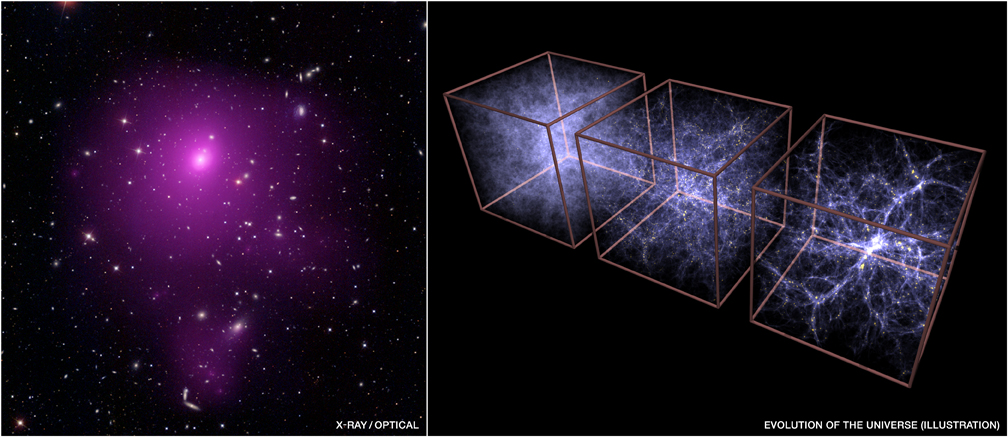
The composite image on the left is of the galaxy cluster Abell 85, located about 740 million light years from Earth. The purple emission is multi-million degree gas detected in X-rays by NASA's Chandra X-ray Observatory and the other colors show galaxies in an optical image from the Sloan Digital Sky Survey. This galaxy cluster is one of 86 observed by Chandra to trace how dark energy has stifled the growth of these massive structures over the last 7 billion years. Galaxy clusters are the largest collapsed objects in the Universe and are ideal for studying the properties of dark energy, the mysterious form of repulsive gravity that is driving the accelerated expansion of the Universe.
The illustration on the right shows snapshots from a simulation by Volker Springel, representing the growth of cosmic structure when the Universe was 0.9 billion, 3.2 billion and 13.7 billion years old (now). This shows how the Universe has evolved from a smooth state to one containing a vast amount of structure. Gas is shown in these snapshots, where the yellow regions are stars and the brightest structures are galaxies and galaxy clusters. The growth of these structures was initially driven only by the attractive force of gravity, but then later there was competition with the repulsive force of dark energy.
Understanding the nature of dark energy is one of the biggest problems in science. Possibilities include the cosmological constant, equivalent to the energy of empty space, a modification in general relativity on the largest scales, or a more general physical field. To help decide between these options, Chandra was used to study the increase in mass of galaxy clusters with time over the last 7 billion years. The results are remarkably consistent with those from previous results that measure the expansion of the Universe using distance measurements, revealing that general relativity works as expected on large scales. The cluster work, in combination with other studies, also provides the strongest evidence to date that dark energy is the cosmological constant, or that `nothing weighs something'.
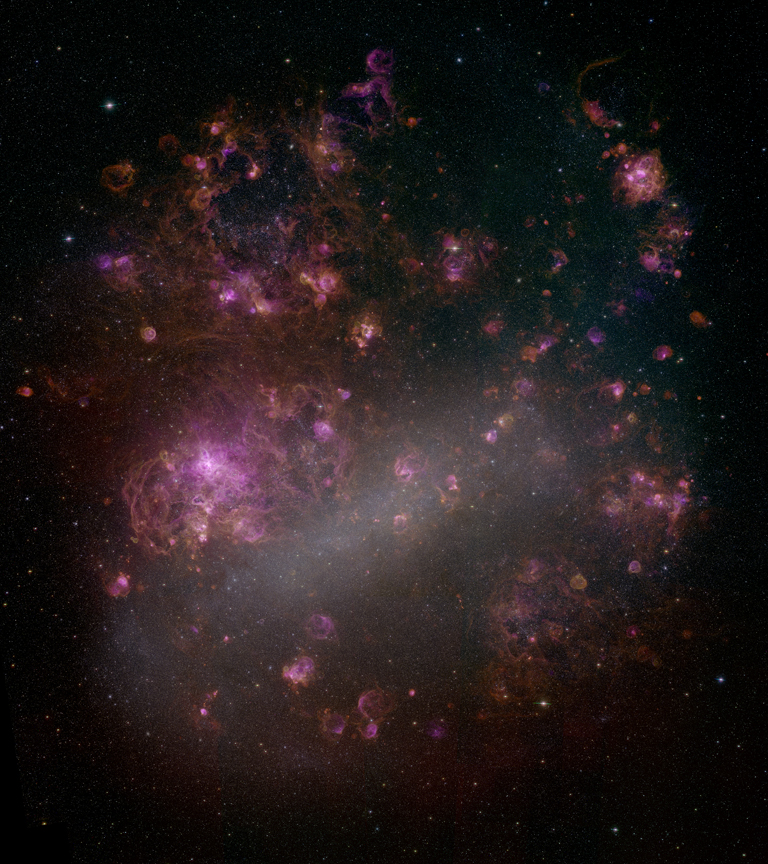

Found in the nearby Large Magellanic Cloud, 30 Doradus is one of the largest massive star forming regions close to the Milky Way. Enormous stars in 30 Doradus, also known as the Tarantula Nebula, are producing intense radiation and searing winds of multimillion-degree gas that carve out gigantic bubbles in the surrounding cooler gas and dust. Other massive stars have raced through their evolution and exploded catastrophically as supernovae, expanding these bubbles into X-ray-brightened superbubbles. They leave behind pulsars as beacons of their former lives and expanding supernova remnants that trigger the collapse of giant clouds of dust and gas to form new generations of stars.
At the center of 30 Doradus lies the star cluster R136 at the intersection of three of these superbubbles. However, with ages only between one and two million years old, the stars in R136 are too young to be source of the supernovae that brighten the superbubbles in X-rays. Instead, R136 is most likely just the latest cluster to form in 30 Doradus. It may be as massive as it is because these superbubbles have combined to concentrate their gas in this region and thus triggered intense star formation there.
30 Doradus is about 160,000 light years from Earth in the southern constellation of Dorado. It spans 800 light years across and is incredibly bright in many wavelengths. If it were at the distance of the Orion Nebula (1,300 light years), 30 Doradus would span the area of 60 full Moons and its optical light would be bright enough to cast shadows at night on the Earth. This latest X-ray image of 30 Doradus represents almost 114,000 seconds, or 31 hours, of Chandra observing time - three times longer than previously recorded. In this image, red represents the lower range of X-rays that Chandra detects, the medium range is green, while the highest-energy X-rays are blue.
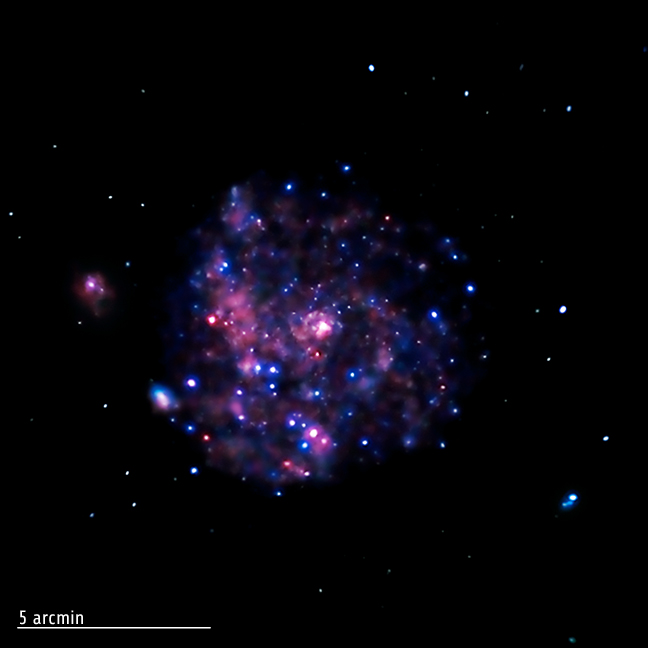
With a diameter of about 170,000 light years, the galaxy Messier 101 (M101) is a swirling spiral of stars, gas, and dust whose diameter is nearly twice that of our Milky Way Galaxy. Its orientation allows telescopes to see the spiral structure of the galaxy face-on, giving inspiration for its nickname of the Pinwheel Galaxy. M101 is found in the Ursa Major constellation and is at a distance of about 25 million light years from Earth.
This Chandra image of M101 is one of the longest exposures ever obtained of a spiral galaxy in X-rays. The point-like sources include binary star systems containing black holes and neutron stars, and the remains of supernova explosions. Other sources of X-rays include hot gas in the arms of the galaxy and clusters of massive stars. These X-ray observations of M101 will be used to establish a valuable X-ray profile of a galaxy similar to the Milky Way. This will help astronomers better understand the evolutionary paths that produce black holes, and provide a baseline for interpreting the observations of distant galaxies.

This image from NASA's Spitzer Space Telescope shows the nasty effects of living near a group of massive stars: radiation and winds from the massive stars (white spot in center) are blasting planet-making material away from stars like our sun. The planetary material can be seen as comet-like tails behind three stars near the center of the picture. The tails are pointing away from the massive stellar furnaces that are blowing them outward.
The picture is the best example yet of multiple sun-like stars being stripped of their planet-making dust by massive stars.
The sun-like stars are about two to three million years old, an age when planets are thought to be growing out of surrounding disks of dust and gas. Astronomers say the dust being blown from the stars is from their outer disks. This means that any Earth-like planets forming around the sun-like stars would be safe, while outer planets like Uranus might be nothing more than dust in the wind.
This image shows a portion of the W5 star-forming region, located 6,500 light-years away in the constellation Cassiopeia. It is a composite of infrared data from Spitzer's infrared array camera and multiband imaging photometer. Light with a wavelength of 3.5 microns is blue, while light from the dust of 24 microns is orange-red.

The Universe in Black and White
Contained within the most massive and active star-forming region in the Small Magellanic Cloud, star cluster NGC 346 delivers energetic radiation that excites nearby gas, causing it to glow. The result is one of the most dynamic and intricately detailed images of a nearby star-forming region that has ever been taken by the Hubble Space Telescope.
Jupiter

ECEMBER 18, 2008: NASA's Hubble Space Telescope has caught Jupiter's moon Ganymede playing a game of "peek-a-boo." In this crisp Hubble image, Ganymede is shown just before it ducks behind the giant planet. This color photo was made from three images taken on April 9, 2007, with the Wide Field Planetary Camera 2 in red, green, and blue filters. The image shows Jupiter and Ganymede in close to natural colors.
Saturn

As Saturn advances in its orbit toward equinox and the sun gradually moves northward on the planet, the motion of Saturn's ring shadows and the changing colors of its atmosphere continue to transform the face of Saturn as seen by Cassini.
This captivating natural color view was created from images collected shortly after Cassini began its extended Equinox Mission in July 2008. It can be contrasted with earlier images from the spacecraft's four-year prime mission that show the shadow of Saturn's rings first draped high over the planet's northern hemisphere, then shifting southward as northern summer changed to spring (see PIA06606 and PIA09793). During this time, the colors of the northern hemisphere have evolved from azure blue to a multitude of muted-colored bands.
This mosaic combines 30 images -- 10 each of red, green and blue light -- taken over the course of approximately two hours as Cassini panned its wide-angle camera across the entire planet and ring system on July 23, 2008, from a southerly elevation of 6 degrees.
Six moons complete this constructed panorama: Titan (5,150 kilometers, or 3,200 miles, across), Janus (179 kilometers, or 111 miles, across), Mimas (396 kilometers, or 246 miles, across), Pandora (81 kilometers, or 50 miles, across), Epimetheus (113 kilometers, or 70 miles, across) and Enceladus (504 kilometers, or 313 miles, across).
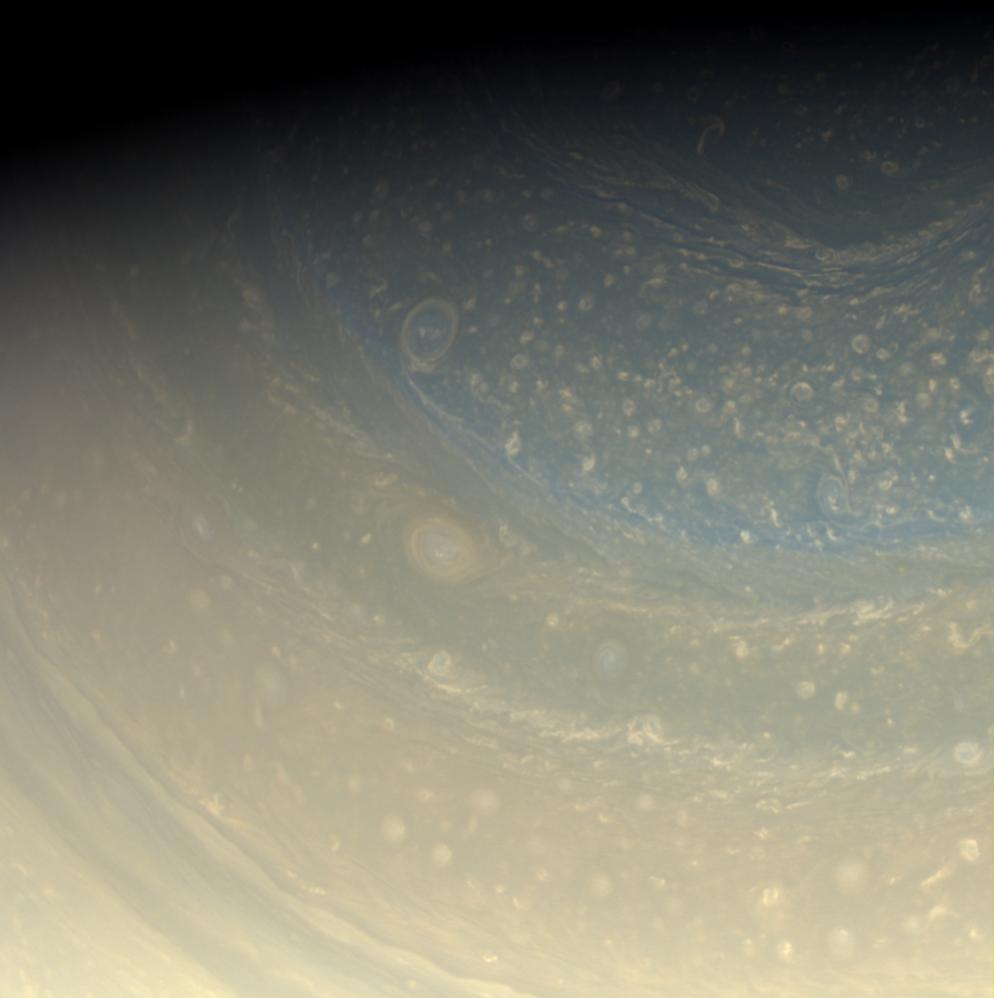
Saturn's north pole is littered with storms, as we see in this color view of the pole. A bit of the north polar hexagon is also visible at the upper-right.
Cassini scientists are looking forward to sunrise on this pole next year so that they can better study it in visible light.
Images taken using red, green and blue spectral filters were combined to create this full color view. The images were obtained with the Cassini spacecraft wide-angle camera on Nov. 16, 2008 at a distance of approximately 673,000 kilometers (418,000 miles) from Saturn and at a Sun-Saturn-spacecraft, or phase, angle of 71 degrees. Image scale is 37 kilometers (23 miles) per pixel.

Details of Saturn's icy rings are visible in this sweeping view from Cassini of the planet's glorious ring system.
This natural color mosaic, taken from 10 degrees below the illuminated side of the rings, shows, from left to right, radially outward from Saturn, the C ring (with its Colombo and Maxwell gaps); the B ring and the Cassini division beyond, with the intervening Huygens gap; the A ring (with its Encke and Keeler gaps); and, on the far right, the narrow F ring. The total span covers approximately 65,700 kilometers (40,800 miles).
Although it is too faint to be seen here, the D ring is located just to the left of the C ring.
It is interesting to compare this view with PIA08389, which shows the unilluminated side of the rings. The difference in brightness of the B ring relative to the other rings is striking. When illuminated directly by the sun, the B ring appears brighter than the adjacent A and C rings; however, when viewing the unlit side of the B ring, the A and C rings appear brighter. This phenomenon occurs because the density of the B ring is greater than that of the A or C rings.
The mosaic was constructed from 45 narrow-angle-camera images -- 15 separate sets of red, green and blue images -- taken over the course of about four hours, as Cassini scanned across the rings.

Dione Has Her Faults
Saturn's icy moon Dione has undoubtedly experienced geologic activity since its formation, as evidenced by the tectonic faults and craters on its surface.
To create this enhanced-color view, ultraviolet, green and infrared images were combined into a single black and white picture that isolates and maps regional color differences. This "color map" was then superposed over a clear-filter image. The origin of the color differences is not yet understood, but may be caused by subtle differences in the surface composition or the sizes of grains making up the icy soil.
This view looks toward the leading hemisphere on Dione.
Mars

Mars today is a world of cold and lonely deserts, apparently without life of any kind, at least on the surface. Worse still, it looks like Mars has been cold and dry for billions of years, with an atmosphere so thin, any liquid water on the surface quickly boils away while the sun's ultraviolet radiation scorches the ground.
But there is evidence of a warmer and wetter past -- features resembling dry riverbeds and minerals that form in the presence of water indicate water once flowed through Martian sands. Since liquid water is required for all known forms of life, scientists wonder if life could have risen on Mars, and if it did, what became of it as the Martian climate changed.
New research reveals there is hope for Mars yet. The first definitive detection of methane in the atmosphere of Mars indicates the planet is still alive, in either a biologic or geologic sense, according to a team of NASA and university scientists.
"Methane is quickly destroyed in the Martian atmosphere in a variety of ways, so our discovery of substantial plumes of methane in the northern hemisphere of Mars in 2003 indicates some ongoing process is releasing the gas," said Dr. Michael Mumma of NASA's Goddard Space Flight Center in Greenbelt, Md. "At northern mid-summer, methane is released at a rate comparable to that of the massive hydrocarbon seep at Coal Oil Point in Santa Barbara, Calif."
Methane -- four atoms of hydrogen bound to a carbon atom -- is the main component of natural gas on Earth. It's of interest to astrobiologists because organisms release much of Earth's methane as they digest nutrients. However, other purely geological processes, like oxidation of iron, also release methane. "Right now, we don�t have enough information to tell if biology or geology -- or both -- is producing the methane on Mars," said Mumma. "But it does tell us that the planet is still alive, at least in a geologic sense. It's as if Mars is challenging us, saying, hey, find out what this means." Mumma is lead author of a paper on this research appearing in Science Express Jan. 15.
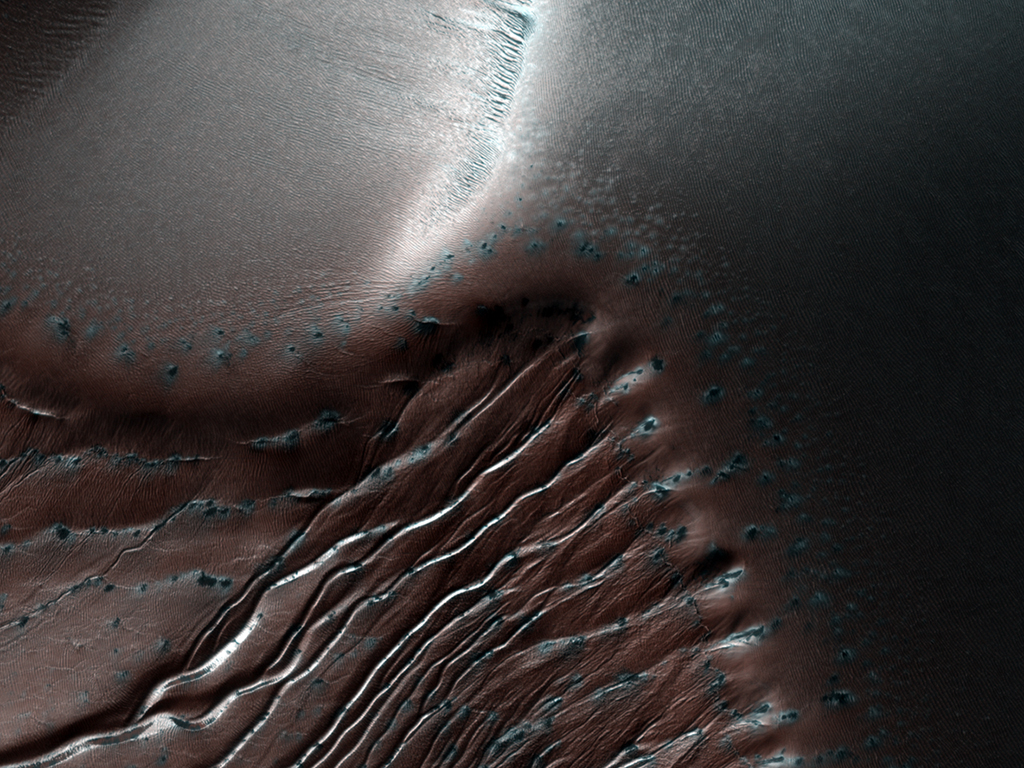
This image represents part of the dune field present in the northeast portion of Russell Crater. The dune field itself is roughly 30 kilometers long, and appears to have formed from windblown material trapped by the local topography.
This HiRISE image was taken during the southern hemisphere�s deep winter, where temperatures are low enough to allow the carbon dioxide frost to be stable. The frost is apparent primarily on the slopes that do not experience full sunlight, and is the target of a long term monitoring program by HiRISE.
Most of the gullies in this image appear to originate near the crests of their respective dunes, and are present on pole-facing slopes. The gullies in this image appear to have only two of the three components of normal gully morphology seen elsewhere on Mars, since they seem to lack a debris apron at their terminus. They have defined alcoves, and have unusually long channels that do not seem to change significantly in width.
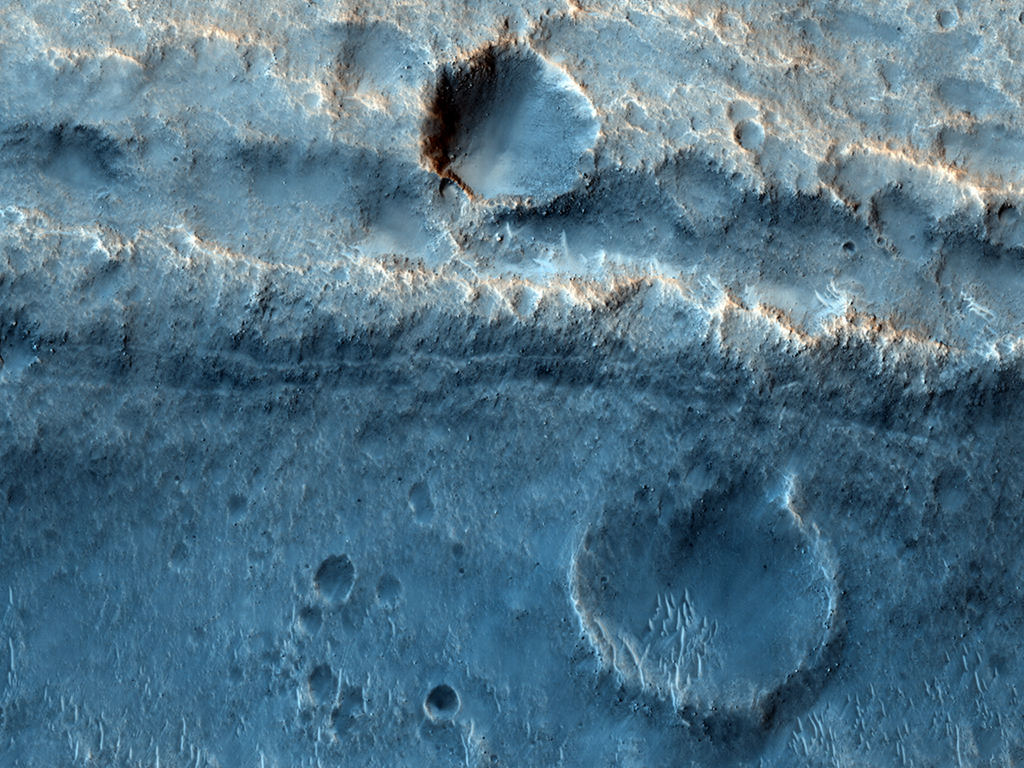
This scene in the Acidalia Planitia contains a variety of features, the most prominent of which are two mesas (hills).
Several craters in the scene have bright material extending outward from their bottom left rims. These are wind streaks that mark the most recent dominant wind direction. The wind blows material out of the craters onto the adjacent plains.
At the bottom of the image are a cluster of craters. These might be secondary craters, which formed when ejecta from one impact hit the surface moving fast enough to create more craters. Secondary craters are identified partly by their occurrence in clumps and similar relative ages because all secondary craters from a single impact form at the same time.

Santorini Panorama
This panorama shows the vista from which NASA's Mars Exploration Rover Opportunity spent five weeks in November and December 2008 while the sun was nearly directly in between Mars and Earth.
Opportunity is approaching the fifth anniversary of its landing on Mars, continuing a surface mission that was initially scheduled to last three months. The rover landed on Jan. 24, 2004.